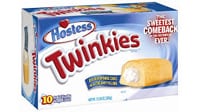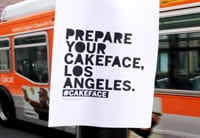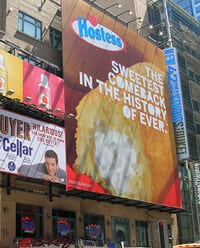Hostess Brands, the company famous for Twinkies, Fruit Pies and Ho Hos, began its journey 95 years ago. On November 11, 2012 disaster struck. The union went on strike for 16 long days. By then, Hostess was out of cash and building up debt. It had no choice but to close the operation and liquidate. But what happened next would be nothing less than astonishing.
 Hostess saw a huge outpouring of emotion from its massive fan base. Social exploded. Comics began appearing in national media satirizing the death of the beloved cream-filled confection. The Twitter-verse exploded with tweets like: “I’m about to take what could be my last bit of anything made by Hostess, wow I’m so done.” and “HOW CAN YOU CLOSE, MY KIDS WON’T EVEN KNOW WHAT A TWINKIE IS NOW!”
Hostess saw a huge outpouring of emotion from its massive fan base. Social exploded. Comics began appearing in national media satirizing the death of the beloved cream-filled confection. The Twitter-verse exploded with tweets like: “I’m about to take what could be my last bit of anything made by Hostess, wow I’m so done.” and “HOW CAN YOU CLOSE, MY KIDS WON’T EVEN KNOW WHAT A TWINKIE IS NOW!”
“It gave you a little thought of what this brand is all about,” Rich Seban, president and COO, Hostess Brands LLC, said at the ANA Brand Masters Conference yesterday.
Then a real break came. A number of investment firms saw the potential of the brand and in March 2013 turnaround specialists Apollo-Metropoulos bought the cake side of Hostess for $410 million.
Three major challenges faced the team to revive the brand: there was no money, no time and, most importantly, the new owner had in mind a less than appealing slogan: “Your Snack is Back.”
“I went into a panic,” Seban said. “I thought my God this can’t happen.”
Seban decided to make a difficult call to Bernstein-Rein, its ad agency since 2005. He told the BR team that Hostess might not be able to pay them for a while but that he needed their help. BR agreed and Seban brought the ad team to Hostess’ home base in Dallas, put them in a room and said don’t’ come out till you have the idea.
“They came to my rescue,” Seban said.
The BR team discussed the fact that Hostess had been a nostalgic brand among older moms, but that the outpouring of support on social media offered a once in a lifetime opportunity to reach a younger demographic that wasn’t really paying attention to Hostess. The idea around a “comeback” surfaced with a launch date of July 15, 2013; just a few short months after the new owners came on board.
“Everybody roots for a good comeback story, but we needed to be bigger than ‘the greatest comeback ever,’ “ Matt Bowne, creative director, Bernstein-Rein, said. “We came up with a simple solution, ‘ The Sweetest Comeback Ever.’ Bam, there we had it.” But the team then took it a bit farther to reach that younger target.
“We needed to talk like our target and asked ourselves how a 20-year-old male would tweet this news or a 45-year-old hip mom. Then the line was born, ‘. The Sweetest Comeback in the History of Ever,‘ ” he said. “It’s too long, not grammatically correct, and the creative director was wondering aloud, ‘how the hell am I supposed to fit this on the box.’ “
With that theme in hand, BR went to work to rally that approach while working for a company with no cash flow and budget under $3.5 million for the campaign, which ran from April 9 to July 15.
“We needed to be efficient so we devised a strategy focused on major market buzz amplified through social media and to start before the product hit shelves,” Bowne said.
 So three weeks prior to the launch, “Prepare Your Cake Face” (reworked from “Prepare your Cake Hole,” so as not to alienate the older audience) was released to America. Content was aggregated on Instagram with a countdown clock ticking off the time until the July 15 on-shelf date. The site was originally created to house only Vine videos, but four days before the product launch Instagram API came out so the team scrambled to add API to the mix. The site performed well and the #cakeface hashtag began trending on Vine. A couple thousands videos were loaded in the first week with users spending an average four minutes per visit. Street teams were dispatched in major markets supporting the “Prepare your Cake Face” messaging and stamping visitors’ hands with the hashtag. When people looked up from the street-team entertainment, walls and building scapes featured the products and the 7.15.13 date. The social engine continued to churn as people took photos of out-of-home executions and shared them with their social communities, including the giant replica of a Twinkie hanging from a Dallas billboard that struck fear into the engineers that it would hold.
So three weeks prior to the launch, “Prepare Your Cake Face” (reworked from “Prepare your Cake Hole,” so as not to alienate the older audience) was released to America. Content was aggregated on Instagram with a countdown clock ticking off the time until the July 15 on-shelf date. The site was originally created to house only Vine videos, but four days before the product launch Instagram API came out so the team scrambled to add API to the mix. The site performed well and the #cakeface hashtag began trending on Vine. A couple thousands videos were loaded in the first week with users spending an average four minutes per visit. Street teams were dispatched in major markets supporting the “Prepare your Cake Face” messaging and stamping visitors’ hands with the hashtag. When people looked up from the street-team entertainment, walls and building scapes featured the products and the 7.15.13 date. The social engine continued to churn as people took photos of out-of-home executions and shared them with their social communities, including the giant replica of a Twinkie hanging from a Dallas billboard that struck fear into the engineers that it would hold.
“Would it be that bad if a Twinkie feel on the road?” Bowne asked. “That would be another national story.”
“This turned into the sweetest promotion in the history of ever,” Seban said. “Customers—like Publics, Kroger and Wal-Mart—began calling us and asking ‘how can we get the products’? I’ve got to have the products.’ That date, 7.15.13 really became a trigger for our customers too.”
The BR team reactivated eight Hostess social spaces.
“These social channels were dormant for eight months,” Bowne said. “We did the worst thing by stopping the engagement. We had to reintroduce and speak to a new generation and entice them to begin following us.”
To further hype 7.15.13, a cupcake box (a brown hat box with a white squiggle across the top) was sent to 70 key celebrity influencers with large followings. Inside the box were Twinkies, cupcakes and a note to please share the word on social. Snoop Dog tweeted: “Just got a special deliver! twinkies are bacc!” ESPN NFL Insider Adam Schefter tweeted a photo of the box. An NFL lineman put out a Vine video with his son who asks, “why are you crying,” with the lineman holding a box of Twinkies next to his cheek. David Letterman told his audience, “News from the world of fine dinning, Twinkies are back. Hostess sent us a box of Twinkies. Twinkies are healthier now. I found that disappointing. The version you can buy now are free range Twinkies.”
“Any mention was a good mention in our mind,” Bowne said.
Hostess met with Kroger and Wal-Mart, 7-Eleven, Walgreens and others who wanted to tie to Hostess’ social program.
By the time 7.15 rolled around it was a frenzy.
Some 300 million cases were built. One retail customer put pallets out in 110 stores and the product blew through in less than one hour. Wal-Mart launched nationally a day early and sold 8,000 pallets in less than one day. Stores sold out of product within 48 hours. The challenge was to keep up on the back end.
“It was an unexpected response to the relaunch,” Seban said. “We ran our factory seven days a week for eight weeks 24 hours a day. It was unbelievable, the response from the American public was the most overwhelming I’ve ever seen.”
National broadcast stations jumped in. A branded snack truck, driven by NBC weatherman Al Roker and the Twinkie the Kid character appeared on the Today Show the morning of July 15. The truck was followed from the air by Good Morning America.
 A mobile app was created for users to identify where to spot the snacks truck, which began a national tour to 15 markets. Out-of-home and social messaging changed over to “The Sweetest Comeback in the History of Ever.”
A mobile app was created for users to identify where to spot the snacks truck, which began a national tour to 15 markets. Out-of-home and social messaging changed over to “The Sweetest Comeback in the History of Ever.”
Over the 12 weeks following launch, Twinkie sales increased 185% and cupcake sales jumped 53%.
“The category, without Hostess, was down double digits. When we came back in—and today—the category is up in excess of 5% resulting in 20% turnaround for the category. Our sales are seven times greater than historic levels,” Seban said. “The return of hostess was great business for our retailers and we’ve ben blessed that the American public welcomed us back,” Seban said.
How is Hostess maintaining long-term growth following the buzz around the relaunch?
“Anybody who wouldn’t be concerned would be in a rabbit hole,” Seban said. “My vision is that we sell where candy bars are sold, which used to be just 35% of our distribution. To appeal to millennial we want to be sold as immediate consumption to drive trial and get lots of new customers.”



